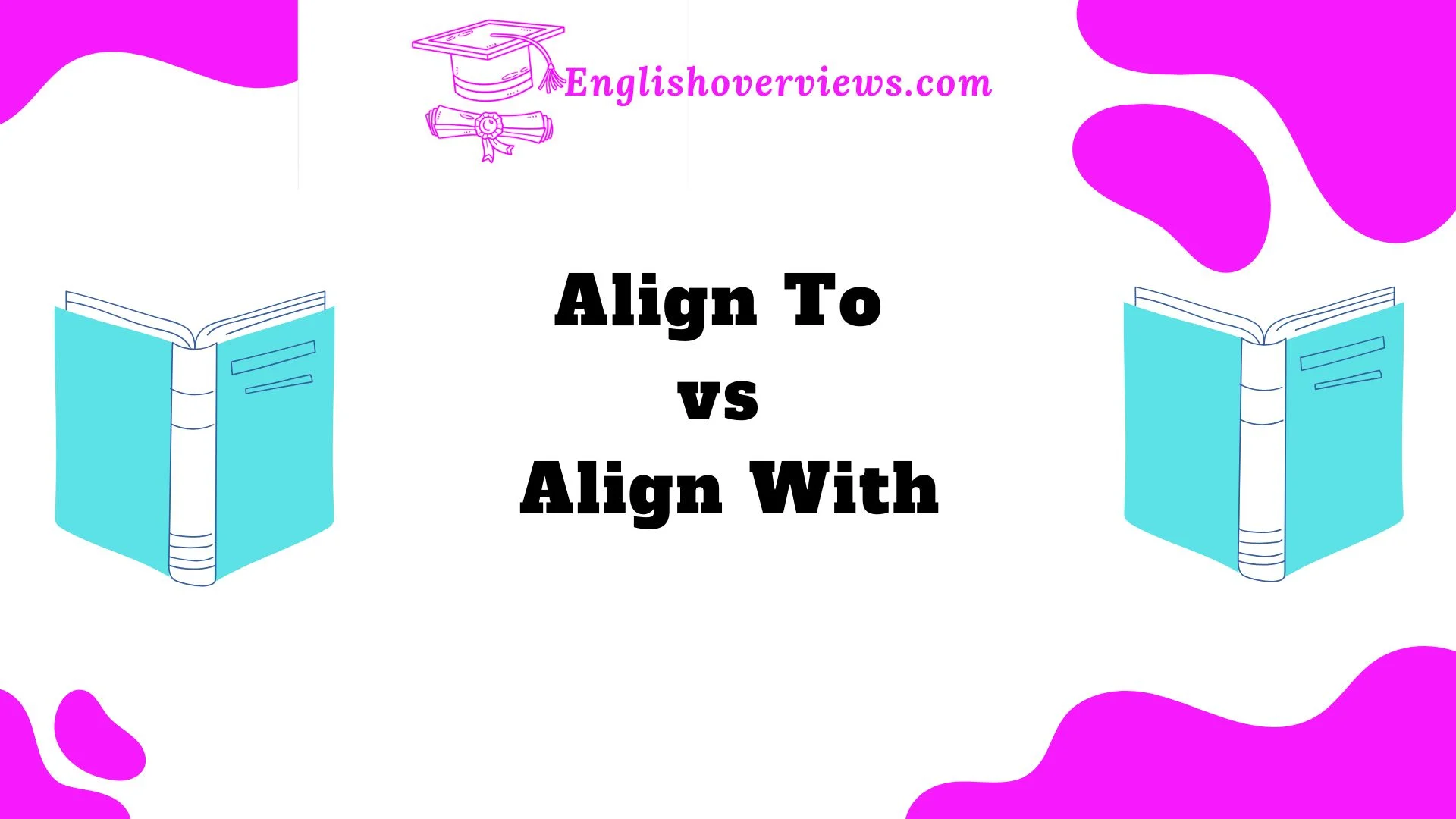Language can be tricky, especially when it comes to choosing the right preposition in different contexts. If you’ve ever found yourself wondering whether to use “align to” or “align with”, you’re not alone.
These two phrases seem similar but can be quite different depending on the context. Whether you’re aligning values, ideas, or physical objects, knowing which preposition to use can make your writing more precise and impactful.
In this article, we’ll break down the differences between “align to” and “align with”, explore when and how to use each one, and offer some clear examples to guide you.
We’ll also look at some common mistakes people make and provide tips to help you always choose the right one. Let’s dive into the world of prepositions, unraveling the mystery of “align to” vs. “align with” once and for all!
Align To: Understanding the Concept
The phrase “align to” is often used when referring to the physical or technical positioning of objects or elements in relation to a specific reference point. It’s about aligning something to a standard, guideline, or a fixed location. The emphasis here is usually on achieving precise positioning or adjustment.
What does “Align To” mean?
When you use “align to”, you’re typically talking about positioning an object, value, or concept in a specific way relative to something else. This could be in terms of direction, distance, or purpose. It’s often used in technical, mathematical, or mechanical contexts where the focus is on precise alignment.
For example, imagine you’re setting up a printing press. You would need to align the paper to the rollers for proper printing. In this case, “align to” indicates that the paper is positioned relative to the rollers, and the focus is on making sure the paper is in the correct position.
When to Use “Align To”
- Physical positioning: In a mechanical or technical setting, such as aligning gears to a motor.
- Geometrical or spatial alignment: Think about aligning an object to a grid, an edge, or a corner in design or architecture.
- Standardization: Aligning values or actions to a set guideline or rule (e.g., “aligning company policies to ethical standards”).
Real-World Example:
Let’s take the example of website design. When designing a page, the content may need to be aligned to the left margin for consistency. In this case, “align to” refers to the precise placement of the content relative to a fixed margin or grid.
Align To: Proper Usage and Examples
Now that we understand the basic concept, let’s explore how “align to” works in various scenarios. This will give you a clearer picture of how to incorporate this phrase correctly into your writing.
Example 1: Align the elements to the grid
When working in graphic design or UI design, it’s essential to position elements in alignment with a grid system. The elements should be aligned to the grid to ensure a consistent and professional layout. Here, you are aligning physical or visual components to a fixed reference, which is the grid.
Example 2: Align your team’s goals to the company’s mission
In a business context, teams are often asked to align their goals to the company’s overarching mission. This refers to ensuring that individual team objectives are positioned in accordance with the company’s core values or strategies.
Example 3: Align the wheels to the center of the car
In automotive mechanics, when aligning the wheels of a vehicle to the center of the car, you’re focusing on the physical positioning of the wheels. The goal is to ensure that everything is centered and aligned to a fixed point.
In these examples, we see that “align to” focuses on the precise, physical positioning of an object or concept relative to something else.
Align With: Understanding the Concept and Proper Usage
On the other hand, “align with” is typically used when referring to agreement, harmony, or coordination between two or more ideas, values, people, or systems. The emphasis here is on cooperation or shared objectives rather than physical positioning.
What does “Align With” mean?
When you use “align with”, you’re often talking about how two or more entities (whether ideas, goals, or values) are brought into agreement or unity. It’s less about physical positioning and more about convergence or harmony.
For example, when a company’s strategy aligns with market trends, it means the company’s plans are in harmony with what’s currently popular or needed in the market.
When to Use “Align With”
- Shared ideas or values: When discussing agreement or coordination between people or entities.
- Strategic alignment: When the goals of one group are in harmony with those of another group or organization.
- Collaboration and cooperation: When two entities work together towards a common goal.
Real-World Example:
Consider a nonprofit organization that works on environmental issues. If the organization’s mission aligns with the values of a local community, it means that both the community and the nonprofit share the same core beliefs and objectives. This usage of “align with” indicates that their goals or values are in harmony with each other.
Examples for “Align With”
Now, let’s look at a few examples where “align with” is the correct choice:
Example 1: Align your personal values with your professional life
When you’re trying to find work-life balance, it’s important that your personal values align with your professional choices. If your job promotes sustainability, for instance, and you also value eco-friendly living, your values are aligned.
Example 2: Align the company’s goals with the needs of the market
In the business world, it’s crucial for companies to make sure that their goals align with the market’s needs. This ensures the company remains competitive and relevant in the industry. In this example, “align with” signifies harmonizing business objectives with market demands.
Example 3: Their approach aligns with modern teaching methods
In education, it’s common to hear that a school’s teaching style aligns with current pedagogical trends. This reflects the agreement between the school’s methods and what is widely recognized as effective in education.
Key Differences: Align To vs. Align With
So, how do “align to” and “align with” differ?
| Align To | Align With |
| Focuses on physical positioning or adjustment | Focuses on agreement or harmony |
| Used in technical, mathematical, or geometric contexts | Used in strategic, conceptual, or value-based contexts |
| Refers to aligning an object to a fixed point | Refers to aligning ideas, values, or objectives |
| Examples: Align the objects to the grid | Examples: Align your vision with the company’s mission |
Key Takeaways:
- “Align to” is used when the focus is on physical positioning or precise alignment to a standard, reference point, or guideline.
- “Align with” is used when discussing agreement, cooperation, or shared goals/values.
Common Mistakes to Avoid: Align To or Align With?
It’s easy to make mistakes when choosing between “align to” and “align with”, especially when the two seem so similar. Here are some common pitfalls to avoid:
- Confusing physical and conceptual alignment: Don’t use “align with” when you’re referring to positioning objects or elements in space.
- Using the wrong preposition when discussing collaboration or shared goals: Avoid “align to” in strategic or value-based contexts—“align with” is always the better choice here.
- Overusing one preposition: It’s important to switch between “align to” and “align with” depending on whether you’re talking about physical positioning or conceptual harmony.
Quick Fix:
Before using either preposition, ask yourself: Are you aligning something physically (go with “to”), or are you talking about agreement or shared goals (go with “with”)?
Tips for Effective Alignment: Choosing Between Align To and Align With
Choosing the right preposition between “align to” and “align with” can seem tricky, but it doesn’t have to be. Here are some practical tips to make sure you’re always choosing the right one:
- Understand the context: If it’s about physical placement, use “align to”. If it’s about shared ideas or goals, use “align with”.
- Ask whether the focus is on positioning or agreement: Physical positioning requires “align to”; conceptual or goal alignment requires “align with”.
- Practice with examples: The more you practice, the more natural it will become to choose the correct preposition.
Conclusion
Understanding when to use “align to” versus “align with” can make a big difference in your writing. By knowing the subtle distinctions, you can communicate more clearly and precisely, whether you’re discussing physical alignment or strategic cooperation.
Remember, “align to” is for physical positioning, and “align with” is for aligning ideas, values, or goals. With this guide in hand, you’ll always know which preposition to choose and be on your way to clearer, more effective writing.
FAQs
- Is it wrong to say “align with” in technical contexts?
- No, but in technical contexts, “align to” is generally preferred. For conceptual alignment, “align with” fits better.
- Can “align to” and “align with” be used interchangeably?
- Not exactly. “Align to” is used for physical positioning, while “align with” is about agreement or shared goals.
- What’s the easiest way to remember when to use “align to” vs. “align with”?
- Ask yourself: Are you aligning something physically (use “to”), or are you aligning ideas or values (use “with”)?
- Are there any exceptions to these rules?
- In most cases, these distinctions hold true. However, in some cases, both might be grammatically acceptable, depending on the context.

English Overviews is a resourceful website dedicated to providing valuable content related to grammar and vocabulary.Babar Naeem has made notable contributions, sharing insights on various subjects, including WordPress themes and plugins. The primary goal of the site is to help users improve their English language skills effectively.











